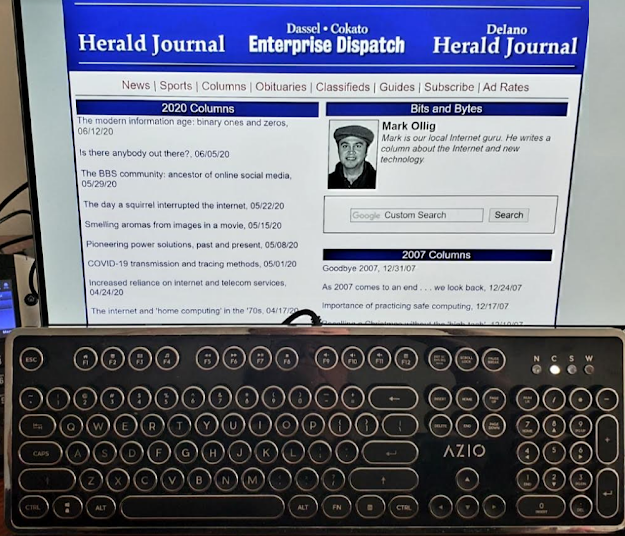© Mark Ollig
How many of my readers recall writing their high school class reports using a manual or electric typewriter?
In the 1960s and 1970s, models of typewriters included Royal, Brother, Olympia, Remington, Olivetti, and the one I used, a Smith-Corona manual typewriter.
These are all QWERTY typewriters, named because the keyboard design is based on the original typewriter made by Christopher Sholes, Carlos Glidden, and Samuel Soule.
If you look down at your keyboard, you will see the first six keys on the top left letter row read: QWERTY.
Sholes arranged the keys in the QWERTY layout to minimize the likelihood of jamming the typebars of the typewriter.
All of us who used typewriters have no doubt encountered “type-bar clash” (when while typing, the metal arms carrying the letters did not retract and thus stuck together).
Sholes, Glidden, and Soule filed a patent Oct. 11, 1867, for their first functioning type-writing machine, made in Charles F. Kleinsteuber’s machine shop at 318 State Street in Milwaukee, WI.
They were awarded a US Patent June 23, 1868, for a type-writing machine that looked more like a small wooden music box and nothing like the typewriters we used back in the day.
The three worked for seven years on mechanical alterations, improvements, and testing. They refined their original model into a machine that could reliably type letters and numbers using an inked ribbon.
The original typewriter operated using long wires to connect the typing bars and key-levers to strike the paper positioned on a flat plate. The letters were all uppercased; no lowercase.
One of the alterations replaced the long wires with a simplified key-bar operation for striking the keys onto the typing paper, which was tissue-thin, unlike today’s thicker typing paper.
A revolving cylinder was used as the paper carrier to rotate enough space for the letters and incorporated an index to change the lines. This cylinder allowed the use of thicker paper.
Another alteration to their typewriter was to use short, stiff wires connecting the key-levers to the typebars at an angle that kept the typed letters on a reliable horizontal alignment on the paper.
“I am satisfied the machine is now done,” declared Sholes in September 1869.
The Sholes, Glidden, and Soule typewriters were being factory-made in Milwaukee during summer 1871, at a makeshift shop between the Milwaukee River and Rock River Canal.
Energy from a watermill near the canal was used by the factory workers to construct each typewriter.
The cost of manufacturing the typewriters turned out to be more than what they were being sold for.
It was decided to look for an established outside manufacturer to make the typewriters.
At the time, E. (Eliphalet) Remington Rand & Sons were manufacturing sewing machines, farm implements, and firearms in Ilion, NY.
A contract was signed March 1, 1873, with Remington to have their chief mechanics rework and produce a minimum of 1,000 typewriters.
E. Remington Rand & Sons eventually purchased the rights to the typewriter.
The new design for mass production called for encasing the production version of the typewriter in metal instead of wood.
The final Sholes, Glidden, and Soule typewriters produced by Remington were the same in form and function as the last Milwaukee-built machines; however, the refinements resulted in significant advancements in the overall design of their typewriter.
In 1874, the first commercially successful mass-produced Sholes & Glidden typewriter for the public was called the Remington No. 1.
It was said this began a revolution in how commerce, business, and communications would be conducted, as this typewriter could write much faster than a person could handwrite.
The News Journal newspaper from Wilmington, DE wrote about the Sholes & Glidden typewriter Oct. 26, 1874, saying, “Sholes & Glidden’s typewriter, an ingenious mechanical key printing machine, very simple in construction and capable of printing from 60 to 75 words per minute.”
The same year, the Remington No. 1 typewriter was being manufactured, John Thomas Underwood and his father began a factory in New Durham, NJ, for manufacturing carbon paper, ink ribbons, and other supplies and accessories used with typewriting machines.
In his autobiography, Samuel Clemens, most notably known as Mark Twain, said he was the first writer to present a publisher with a typewritten manuscript for his book, “The Adventures of Tom Sawyer,” in 1876.
In 1886, E. Remington and Sons sold their typewriter interests to the Standard Typewriter Manufacturing Company, whose owners previously worked for Eliphalet Remington.
In 1902, Standard Typewriter Manufacturing Company changed its name to the Remington Typewriter Company.
In 1927, Remington Typewriter Company merged with the Rand Kardex company and became Remington Rand.
In 1950, Remington Rand acquired the Eckert-Mauchly Computer Corporation, which made the ENIAC computer.
In 1951, Remington Rand came out with the UNIVAC computer.
In 1955, Remington Rand was purchased by Sperry Corporation.
Since 1986, Sperry Corporation has been a part of the information and technology company called Unisys.
Sholes died Feb. 17, 1890, aged 71.
Glidden passed away March 11, 1877, at the age of 42.
Soule died July 12, 1875; he was 45 years old.
US Patent 79265 for Sholes, Glidden, and Soules’s Type Writing Machine was awarded June 23, 1868. It can be seen at https://bit.ly/3eaGDiQ.
Today’s computer keyboards are very advanced; however, I still enjoy using the vintage qwerty typewriter-style keyboard with its tactile feel and clicky-sounding mechanical keys.
Stay safe out there.
 |
| My computer typing terminal with the qwerty typewriter-style keyboard, tactile feel, and clicky-sounding mechanical keys. :) |
 |
| US Patent 79265 for Sholes, Glidden, and Soules’s Type Writing Machine |




